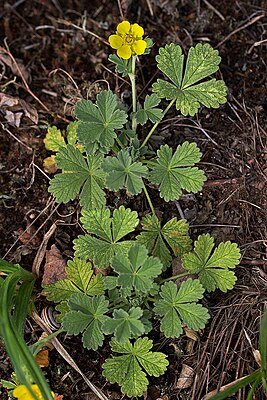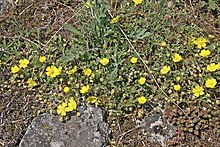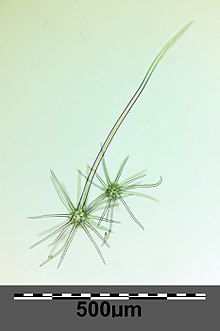Sand cinquefoil
| Sand cinquefoil | ||||||||||||
|---|---|---|---|---|---|---|---|---|---|---|---|---|

Sand cinquefoil ( Potentilla incana ) |
||||||||||||
| Systematics | ||||||||||||
|
||||||||||||
| Scientific name | ||||||||||||
| Potentilla incana | ||||||||||||
| G. Gaertn. , B.Mey. & Scherb. |
The sand cinquefoil ( Potentilla incana P. Gaertn., B. Mey. & Scherb. ) Is a species of the rose family (Rosaceae). It occurs very frequently to very rarely in Central Europe.
description
The sand cinquefoil differs from the spring cinquefoil ( Potentilla neumanniana ), to which it is otherwise very similar, by the dense hair with multi-rayed star hairs. The underside of the leaf is very dense tomentose, star-haired and therefore colored light gray-green, on the upper side the hair is slightly less dense. However, the two types cannot always be strictly separated from one another, as so-called intermediate forms occur. In addition, it is not uncommon for Potentilla neumanniana and Potentilla arenaria = Potentilla x subarenaria Zimmeter to hybridize .
The sand cinquefoil is a perennial herbaceous plant that reaches heights of 5 to 15 cm. Turf-like stands are formed, but without runners-like elongated rhizomes . The stems and especially the underside of the leaves are more or less densely covered with 15 to 25 (6 to 35) -radiated star hairs and also with small, light-colored glands. The flower stalks have star hairs and glands. The radially symmetrical flowers have a diameter of 8 to 12 mm. The petals are yellow. It blooms between March and May.
The number of chromosomes is 2n = 28 or 35.
distribution
Site conditions
Potentilla incana is a light and heat-loving plant that grows in dry, nutrient-poor, base-rich, sandy, stony or rocky locations. It prefers sandy corridors and dry limestone lawns or light dry pine forests. In Central Europe it is a Festucetalia-valesiacae-order character, but also occurs in societies of the associations Xerobromion or Cytiso-Pinion.
General distribution
The sand cinquefoil is a European-continental floral element. The western border runs from Alsace to the Nahe valley. The area extends through Central and Eastern Europe to the southern Ural region and the northern Caucasus. In the north, the border stretches across the north German plains to southern Sweden and the Baltic states. In the south, the border runs from Basel along the Rhine to Lake Constance, on to Austria via Hungary and Yugoslavia to the Black Sea in Bulgaria.
Distribution in Germany
The sand cinquefoil is found scattered in central and eastern Germany. In addition, it is rare or absent.
Distribution in Austria
In Austria, the sand spring cinquefoil occurs very frequently in the Pannonian region , otherwise it occurs scattered or rarely. The deposits extend to the federal states of Vienna , Lower Austria , Burgenland , Upper Austria , Styria and Carinthia . It is considered endangered in the northern foothills of the Alps.
Taxonomy
Synonyms for Potentilla incana P. Gaertn., B. Mey. & Scherb. are: Potentilla arenaria Borkh. , Potentilla arenaria subsp. incana (P. Gaertn. & al.) O. Schwarz , Potentilla cinerea subsp. incana (P. Gaertn. & al.) Asch. , Potentilla verna subsp. incana (P. Gaertn. & al.) Schübler & G. Martens .
Others
Due to the strong tendency to hybridize and resemble the spring cinquefoil , the species is often ignored.
Individual evidence
- ↑ a b Erich Oberdorfer : Plant-sociological excursion flora for Germany and neighboring areas . 8th edition. Verlag Eugen Ulmer, Stuttgart 2001, ISBN 3-8001-3131-5 . Page 541-542.
- ^ Manfred A. Fischer, Karl Oswald, Wolfgang Adler: Excursion flora for Austria, Liechtenstein and South Tyrol . 3rd, improved edition. Province of Upper Austria, Biology Center of the Upper Austrian State Museums, Linz 2008, ISBN 978-3-85474-187-9 , p. 485 .
literature
- Henning Haeupler , Thomas Muer: picture atlas of the fern and flowering plants of Germany (= the fern and flowering plants of Germany. Volume 2). Published by the Federal Agency for Nature Conservation. Ulmer, Stuttgart 2000, ISBN 3-8001-3364-4 .
- Wolfgang Adler, Karl Oswald, Raimund Fischer: Excursion flora of Austria. Ed .: Manfred A. Fischer . Ulmer, Stuttgart / Vienna 1994, ISBN 3-8001-3461-6 .
- August Binz , Christian Heitz: School and excursion flora for Switzerland , Schwabe & Co. AG, Basel, 1986, ISBN 3-7965-0832-4
- Erich Oberdorfer : Plant-sociological excursion flora , Ulmer Verlag, Stuttgart, 1990, ISBN 3-8001-3454-3
- Christian August Friedrich Garcke : Illustrierte Flora , 1972, Paul Parey publishing house, ISBN 3-489-68034-0
Web links
- Sand cinquefoil. In: FloraWeb.de.
- Sand cinquefoil . In: BiolFlor, the database of biological-ecological characteristics of the flora of Germany.
- Profile and distribution map for Bavaria . In: Botanical Information Hub of Bavaria .
- Potentilla incana P. Gaertn. & al. In: Info Flora , the national data and information center for Swiss flora . Retrieved November 7, 2015.
- Potentilla acaulis L. In: den virtuella floran. Retrieved February 13, 2013 (Swedish).
- photos




